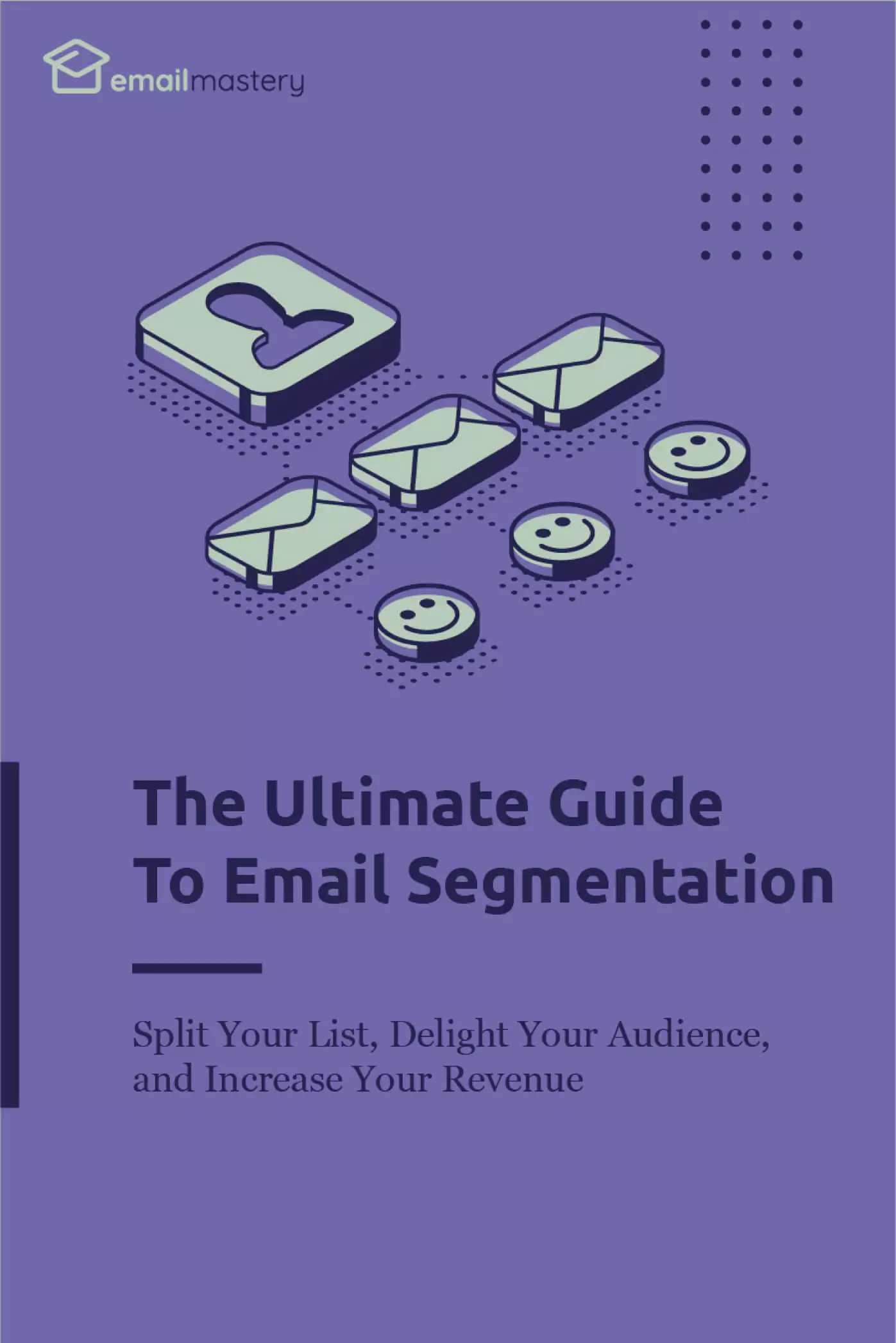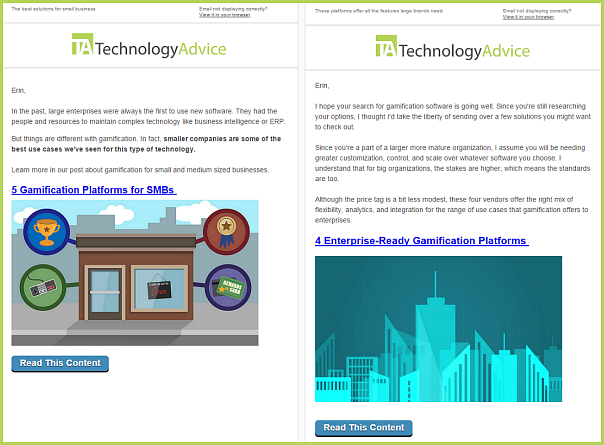
Chapter 3: The Nitty-Gritty How-To Of Email Segmentation
You understand why segmentation is important (because it delights customers and increases email marketing performance). You also are familiar with some of the most common email segments that marketers use to enhance the relationship with their subscribers.
Now we turn our attention to the nitty-gritty how-to process of actually segmenting your list.
The important thing is that you put a little forethought into why you’re segmenting your list, what you want to accomplish, and how best to accomplish that before you create any tags or sub-categories in your ESP.
Email segmentation can be extremely powerful if you know what you’re doing before you do it, but it can be extremely confusing if you dive head-first without much forethought.
With that in mind, here are the five steps you should follow to build your segmentation strategy.
Step #1: Determine your email segmentation goals.
Why do you want to segment your email list?
We’ve talked about how email segmentation can delight your subscribers, help you engage your audience more consistently, and even convert more skeptics into paying customers.
But still, you need your own specific reason for segmenting your email list.
Do you want to sell more products? Do you want to increase content engagement overall? Do you want to improve a specific metric like click-through rate, deliverability, or bounce rate? Do you simply want to decrease your unsubscribe rate?
Maybe your answer is D) All of the above. And that’s okay. Write down all of the reasons that you want to segment your email list. This is going to help you decide how to segment your list to accomplish your goals.
But you must start with specific goals in mind.
Step #2: Decide what segmentation(s) will help achieve your goals.
Once you know why you want to segment your email list, you can then determine which segments are going to help you achieve your goals.
Start by scanning through Chapter 2 and figuring out which segments will have the biggest impact on what you’re trying to accomplish.
Let’s imagine, for example, that you want to increase your email deliverability rate and decrease your unsubscribe rate. In that case, you would likely want to segment your email list by things like…
- Number of emails they want to receive per week.
- Type of content they want to receive.
- When they want to receive that content.
After all, the more that your emails match each subscriber’s specific preferences, the better your deliverability and unsubscribe rates are going to be.
If you’re trying to increase the number of sales you make per email, though, then you might consider measuring email segments such as…
- Specific product interests.
- Demographic purchasing tendencies.
- Sales funnel position.
However, keep in mind that there’s a point of diminishing returns with more complex email segments.

That is, there’s a point where the effort it takes you to collect data and execute the plan for a specific email segment isn’t worth the ROI you’ll receive.
Some big-budget and big-data companies can justify segmenting their list based on complex data and behavioral tendencies (i.e. subscribers who visited a certain page for less than 5 seconds). But remember, do the best you can with what you have.
If you have the budget and bandwidth to create a complex series of segments that will help accomplish your email marketing goals, then go for it! But if you’re new to email segmentation, don’t overwhelm yourself: start basic and add more complex ideas down the road when it makes sense.
Step #3: Choose your segmentation thresholds.
You know which segments will support your email marketing goals. But it’s not enough to know that segments based on a subscriber’s position in the sales funnel, for example, is going to help you make more sales. You also have to know where the threshold lies for each of the segments you’ve chosen.
That is, when does a subscriber go from disengaged to engaged? When does a subscriber go from a new customer to a committed customer? When will you count a subscriber as being interested in a specific product type and when is it safe to assume those interests have changed?
For instance, you might decide to classify a subscriber as “at risk of unsubscribing” if they haven’t opened or clicked an email for more than 3 months. Or maybe you decide 6 months is more reasonable. If you’re segmenting based on interests, then you might choose to classify a subscriber as “interested in kid’s clothing” once they’ve purchased a kid’s product, or maybe just after browsing the kid’s section of your website.
The point is, to bring your segments into reality, you have to choose tangible thresholds for when a subscriber enters or leaves a specific group. Not all segments will need to be fluid and flexible (a person’s ethnicity, for example, will stay the same), but those that are need clearly defined thresholds.
Next to the segments you’ve chosen, write down what thresholds you will use to define those groupings.
Step #4: Create the blueprint for your segmentation plan.
You’re getting some good clarity on your segmentation strategy. You have clear goals for why you’re splitting your list, you know which segments you’re going to use, and you even know where the threshold is at on those separate groupings.
But before you move that segmentation strategy into your ESP or custom email service, we highly recommend outlining your entire plan on a piece of paper.
Visualizing your segmentation strategy will help you clearly see any overlapping discrepancies you might run into (if a subscriber meets the criteria for two different but opposing segments, for example, that could be a problem), and it will help you get a feel for how different segments work together.
Also, documentation is always a good idea. If you decide to switch ESPs or CRMs in the next few months, you don’t want to have to go crawl through your automated campaigns to figure out what your segmentation strategy looks like. Document your plan now so you don’t hit roadblocks later.
You can pull from these four pillars to outline your segmentation strategy.

You can also use a free tool like Visme to create your visual email segmentation workflow.
Step #5: Automate data collection and implementation.
At this point, you should have some idea where you’re going to pull data for your different email segments.
Most high-quality ESPs will give you access to at least some demographic data you can make use of. Google Analytics is also a useful tool when it comes to measuring website engagement or tracking UTMs. If your segmentation plan involves leveraging more complex behavioral data, then you might consider signing up with a CRM like Hubspot or Salesforce.
To a large degree, the nitty-gritty details of how you automate data collection and implementation comes down to which ESP you’re using and what software you have access to.
Here are the segmentation guides for some of the more popular ESPs.
- Mailchimp — All the Segmenting Options
- Klaviyo — Advanced Segmentation
- ActiveCampaign — List Segmentation For Email Marketing
- Drip — Segments
Also, it’s worth noting that there’s a difference between implicit data and explicit data collection. Implicit data is information you can gather quantitatively…
- Where are they spending the most time on your site?
- Which ad channel did they come through?
- Which lead magnet did they download?
- Did they share your content on social media?
Explicit data, on the other hand, is gathering information which your subscribers actually provide for you…
- Email address
- Name
- Zip code
- Demographic info
There’s some overlap here, though. For example, you can gather interest data implicitly or explicitly — you could determine whether someone is interested in wine or whiskey by asking them directly or you can look at their behavior on your website, for example.
The trick is to find the most accurate and simple way to gather data for a given segmentation. If you want to know the gender of each subscriber, for instance, you could include that as a question on a step-2 form when someone signs up for your list (explicit) or you could gather behavioral data about whether they’re viewing boy products or girl products on your website (implicit). Both would work fine. The two things you must consider when choosing a data-gathering method are…
- Ease of gathering data — How easy is it to gather the data for your segmentation? Ideally, it should be an automatic process that you don’t have to do leg-work for every day.
- Accuracy of data — How accurate will the data be if you collect it this way? While one method might take more time, it also might provide more accurate data and thus more profitable segmentation results.
Look at the pros and cons of your data-gathering strategy and choose whichever will be the most accurate and cost you the least amount of time and money.
Step #6: Create email campaigns for each segmentation.
The final step to segmenting your email list is to create email campaigns based on different behaviors, interests, or demographics.
In some cases, this is going to be an ongoing process. If you own an ecommerce store, for instance, and you’ve decided to segment your list by gender, then you’ll likely need to create separate email offers for men and women every time you’re offering a discount (which is worth keeping in mind when choosing your groupings: some segments will double your every-day work-load).
Here’s an example of emails that sent to different cohorts — the left email was sent to small business owners and the right email was sent to leaders of big corporations.

In other cases, this will be a matter of altering automated email sequences to send segmentation-specific content to different subscribers when the time comes.
Or you might create some behaviorally triggered emails (abandoned cart or re-engagement campaigns, for example), which automatically send when subscribers take (or don’t take) a specific action.

Conclusion
There you have it!
That’s how you create a segmentation strategy for your email marketing efforts that’s based on foundational goals, tangible data, and clear criteria. In fact, we’d recommend being careful about segmenting your email list until you’ve gone through all six of these steps.
Don’t get ahead of yourself.
Email segmentation can be an asset to your business or it can complicate things far more than it needs to. Putting in a little forethought and taking your time will help you create segments which benefit your business for the long-run.
